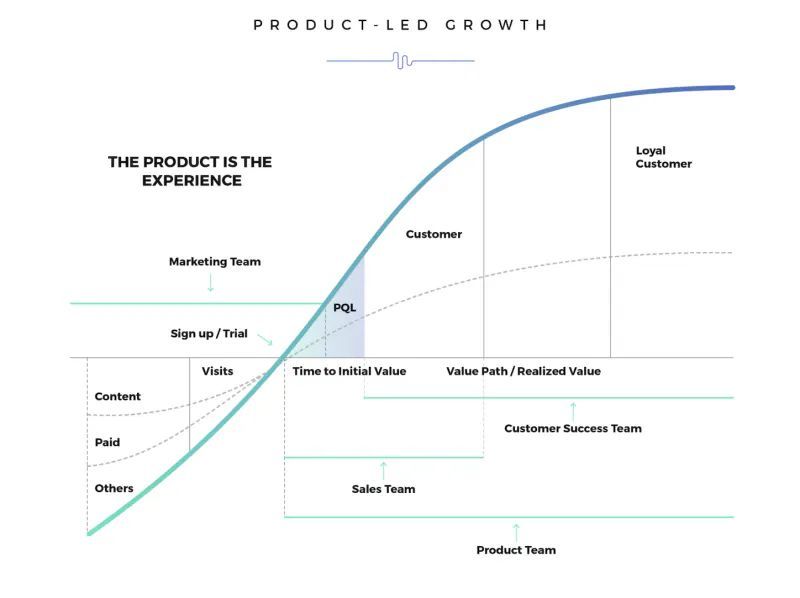In such a cross-functional role that the Product is, the complexities tend to become overwhelming already in early stages of scaling and earlier than the organisation can afford to hire a dedicated ProductOps Manager. A lot of the responsibilities start falling on Product Managers to figure out how to streamline their analytics, communicate decision-making across the organisation and integrate automations into their workflow. In reality no Product Manager is getting paid to do that, and can be damaging to their results in the long run – distracting from strategy development and get stuck in the nitty gritty of operations.
Sitting through tooling demos day after day, trying to figure out their organisational needs and then getting their teams on board is a full-time job. Instead of mapping their customer needs, they’ll end up sitting in meetings with their team, mapping out their own needs. In some cases PMs are able to access AI & Automation Specialists, but will still need to be part of the procurements as the general technically skilled role has no understanding of the internal processes. That’s becoming apparent for growth-stage companies and the ProductOps role is starting to show up in job listings more frequently. The role doesn’t have a strong standard developed yet, and can be named in various ways at different levels.
Introduction
As user acquisition accelerates and revenue scales, the foundational systems that enabled initial growth begin to exhibit stress. Even though product adoption is soaring, feature usage is climbing and teams are riding the wave of success, the very growth you achieved begins to gnaw at your operational efficiency. Data fragments across dozens of tools because teams operate in silos and what once felt like startup agility now resembles corporate bureaucracy. This isn’t failure—it’s the predictable plot twist every scaling company faces.
The Scaling Paradox: When Success Breeds Operational Complexity
This operational degradation represents a systematic challenge inherent to scaling, and not to be seen as an execution failure. Many have started to figure out the solution. The numbers tell a compelling story: ProductOps as a skill on LinkedIn has surged 80% year-over-year, while product-led companies are achieving profit margins that exceed their peers by an astounding 527%. It’s evidence of a fundamental shift in how successful organisations approach scale.
The rise of ProductOps reflects heightened expectations around customer experience, the explosion of product usage data and most critically – the operational complexity that accompanies product-led success. PLG scaling strategies create statistically significant increases in operational complexity because – every user interaction generates data that should be aggregated and analysed. Which simultaneously requires coordination across teams that previously operated independently. Building into a cascading effect where the volume of user-generated insights overwhelms existing analysis capabilities, forcing teams to spend more time managing information than acting on it.
Without proper operational infrastructure, complexities become a growth ceiling rather than a growth engine.
What’s fascinating is that ProductOps hasn’t emerged because the challenges are new—they’ve always existed. Rather, organisations are recognising that grouping these operational responsibilities into dedicated roles and teams isn’t just more efficient; it’s essential for sustainable scaling. Organisations face predictable problems that, if unaddressed, can constrain growth regardless of product quality.
The convergence of PLG methodologies and ProductOps capabilities represents more than an operational evolution—it’s a competitive transformation. In the following exploration, we’ll dissect why product-led growth creates unique scaling challenges, examine the principles that make ProductOps effective and reveal how these disciplines combine to create organisations that scale efficiently while maintaining the agility that drove their initial success.
Product-Led Growth: Inverting the Traditional Scaling Equation
Product-Led Growth (PLG) breaks the traditional scaling equation by making each additional customer progressively cheaper to acquire and serve. In sales-led models – acquiring 100 customers requires roughly 10x the effort of acquiring 10 customers—you need more salespeople, more support staff, more onboarding specialists. Product-led companies invert this relationship: once the product successfully onboards and activates the first 1,000 users, the infrastructure exists to onboard the next 10,000 at a marginal cost. The work of explaining value, demonstrating capabilities and enabling success happens inside the software itself rather than through human labor that must scale linearly with customer count.
The mathematics of product-led growth reveals an almost mystical transformation in how organisations scale. When Figma generates one dollar of new gross profit for every dollar spent on sales and marketing while Adobe—despite its massive resources—achieves only thirty-nine cents, we’re witnessing something fundamentally different from traditional business scaling. This isn’t incremental improvement; it’s architectural transformation.
The alternative—continuing to scale through traditional hiring—carries predictable consequences. Organisations pursuing this path inevitably become bloated entities struggling to respond at the velocity required for competitive advantage. They accumulate coordination overhead that transforms startup agility into enterprise bureaucracy, ultimately achieving higher costs and lower profit margins while moving slower than their product-led competitors. When Notion scaled from 20 million to 100 million users while maintaining only 10% of its workforce in sales, the product itself became the primary engine of customer acquisition, activation and expansion.
This scaling mechanism creates a counterintuitive challenge. Organisations implementing product-led strategies often discover that the very efficiency driving their growth generates operational complexity that exceeds traditional sales-led models. Figma’s transformation from a design tool to a platform supporting 84% of designers collaborating weekly with developers illustrates this phenomenon—success breeds coordination demands that didn’t exist when sales teams managed customer relationships through linear, predictable processes.
This paradox explains why successful product-led companies inevitably encounter an operational ceiling. Viral growth accelerates user acquisition faster than organisations can build the infrastructure to support that growth. Each new user arrives through different pathways—shared links, referrals, organic discovery—creating diverse onboarding journeys that existing systems weren’t designed to handle. The product-led growth engine that eliminates traditional sales inefficiencies simultaneously generates sophisticated collaborational requirements that traditional organisational structures don’t address.
Understanding this paradox reveals why ProductOps has emerged as the operational backbone enabling sustained product-led scaling rather than merely another administrative function.
ProductOps as Scaling Infrastructure: Three Core Mechanisms
ProductOps creates scaling capacity through three distinct mechanisms that traditional organisational structures cannot replicate. The first mechanism—data infrastructure—builds pipelines, standardised metrics and governance frameworks that eliminate repeated analysis work. The second mechanism—process standardisation—converts unique coordination events into repeatable systems. The third mechanism—cross-functional enablement—transforms ad-hoc communication into structured information flow. When Oscar Health implemented ProductOps in 2021, they weren’t adding management layers; they were building these systems to prevent tactical work from consuming Product Managers as the organisation grew.
Data Infrastructure: Building Reusable Decision-Making Systems
A world-class athlete doesn’t improve performance by working harder during competition—they improve through systematic training-structure that builds capacity before it’s needed. Similarly, ProductOps doesn’t accelerate individual product decisions; it constructs the data pipelines, standardised metrics and governance frameworks that enable Product Managers to make decisions rapidly. Avoiding recreating analysis infrastructure for each choice, every single time. When reusable decision-making systems exist, the speed of execution increases while the cognitive load decreases. Freeing up the strategic minds from everyday chores.
Process Standardisation: From Unique Events to Repeatable Systems
Process standardisation operates by eliminating the need to treat each execution cycle as a unique event. Stripe’s execution scale demonstrates this principle in practice. Their ProductOps team of 50 professionals orchestrates over 200 beta tests and product launches annually while deploying more than 3000 API versions. This velocity becomes possible because ProductOps established repeatable coordination mechanisms, rather than managing each launch as a unique event. The infrastructure handles systematic elements—stakeholder notifications, data synthesis, cross-functional alignment—allowing Product Managers to focus on strategic decision-making that actually requires human judgment.
Data infrastructure builds scaling capacity by making insights accessible without recreating analysis each time decisions require information. When Spotify’s ProductOps eliminated large-group status meetings through automated task assignment and progress tracking, they weren’t simply reducing Time Spent in Meetings. They transformed asynchronous information flow from a bottleneck into a scaling advantage. Status information that previously required aggregated human effort now flows automatically to stakeholders who need it, when they need it, without consuming Product Management’s capacity.
Cross-Functional Enablement: Transforming Communication Flow
Cross-functional enablement operates through communication protocols that prevent business goal alignment from degrading as teams multiply. When high-pressure periods force companies toward tactical execution, ProductOps-supported teams maintain capacity for strategic work because operational infrastructure handles coordination work that would otherwise consume Product Management’s attention. The mechanism functions by converting repeated meetings into systematic workflows.
Understanding this operational architecture reveals why product-led organisations—already operating at high velocity—require ProductOps to sustain that velocity as they scale.
Implementing ProductOps for Sustained PLG Velocity
The organisations cracking the code for PLG scaling aren’t working harder. They’re working systematically with ProductOps as their infrastructure leads rather than their emergency response team. When viral adoption outpaces a company’s ability to establish consistent processes, they’re not riding a rocket ship; they’re strapped to a runaway freight train with no one in the conductor’s cabin.
The very mechanism that drives explosive adoption—frictionless user onboarding, viral loops, self-serve conversion pathways—simultaneously fragments the data across multiple personas, multiplies the feedback channels and turns a once-elegant product department into a communicationally challenged problem factory. As Blake Samic demonstrated at Stripe, orchestrating slick operations doesn’t happen through heroic Product Manager multitasking. It requires a structure. A perspective. An ownership and ability to influence outcomes.
The principles of ProductOps that create scale aren’t about adding process bureaucracy—they’re about building the connective tissue that holds hypergrowth together. Stripe’s global team established centralised systems that all product teams could plug into: launch calendars, feedback synthesis frameworks and automated reporting that transformed chaos into choreography.
ProductOps creates scalability by monitoring product health metrics automatically, establishing single sources of truth across fragmented data systems and enables asynchronous cross-functional coordination that survives timezone multiplication. When Uber aligned ProductOps managers to senior product and engineering leaders, they weren’t adding more managers—they were building the operational backbone that allows product-led companies to scale without collapse.
Key Takeaways: Mastering PLG Scaling Through ProductOps
- Product-led growth creates a scaling paradox where viral success generates operational complexity faster than traditional structures can handle. While PLG makes customer acquisition progressively cheaper—inverting the sales-led model where costs scale linearly—it simultaneously fragments data across multiple user pathways and creates coordination demands that exceed traditional sales-led models.
- ProductOps builds scaling capacity through three distinct mechanisms that traditional organizational structures cannot replicate: data infrastructure eliminates repeated analysis work through reusable decision-making systems, process standardization converts unique coordination events into repeatable workflows, and cross-functional enablement transforms ad-hoc communication into structured information flow that survives organizational growth.
- Successful PLG organizations treat ProductOps as infrastructure rather than emergency response or process bureaucracy. Companies like Stripe orchestrating 200+ annual launches with 50 ProductOps professionals demonstrate that systematic operational backbone—not heroic Product Manager multitasking—enables sustained velocity at scale while maintaining the agility that drove initial success.


